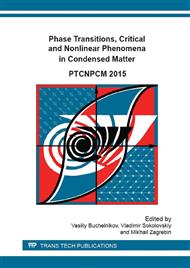[1]
A.N. Lachinov, N.V. Vorobyova, Electronics of thin wideband polymer layers, Advances in Physical Sciences. 176 (12) (2006) 1249-1266.
Google Scholar
[2]
A.N. Lachinov, V. M. Kornilov, T. G. Zagurenko, A. J. Zherebov, To the question about high conductivity of non-conjugated polymers. ZhETF. 129(4) (2006) 728.
Google Scholar
[3]
M.G. Zolotukhin, V.A. Kourdakov, S.N. Salazkin, S.R. Rafikov, Some regularities of synthesis polyarylenephthalides homopolycondensation n-(3-chloro-3-phthalidyl)–biphenyl, Polymer Science. 26a (6) (1984) 1212–1217.
DOI: 10.1016/0032-3950(84)90047-9
Google Scholar
[4]
A.G. Milnes, Deep Impurities in Semiconductors, Wiley-Interscience, New York, (1973).
Google Scholar
[5]
G.F.J. Garlick, A.F. Gibson, The electron trap mechanism of luminescence in sulphide and silicate phosphors, Proc. Phys. Soc. 60 (A) (1948) 574-590.
DOI: 10.1088/0959-5309/60/6/308
Google Scholar
[6]
L. I. Grossweiner, A note on the analysis of first order glow curves, J. Appl. Phys. 24 (1953) 1306.
Google Scholar
[7]
P.S. Pickard, M.V. Davis, Analysis of Electron Trapping in Alumina Using Thermally Stimulated Electrical Currents, J. Appl. Phys. 41 (1970) 2636-2644.
DOI: 10.1063/1.1659274
Google Scholar
[8]
A.S. Nakaryakov, A.N. Lachinov, A.F. Ponomarev, E.E. Tseplin, V.A. Antipin, Evaluation of the energy distribution of trap states in polymer films. Physics of the Solid State. 53 (12) (2011) 2525-2531.
DOI: 10.1134/s1063783411120171
Google Scholar
[9]
V. Kh. Il'yasov, A. N. Lachinov, A. V. Moshelev, A. F. Ponomarev, Estimation of parameters of charge carriers near the threshold of the polymer thermally switching, Physics of the Solid State. 50 (3) (2008) 568-572.
DOI: 10.1134/s1063783408030293
Google Scholar
[10]
R. Bindi, D. Lapraz , P. Iacconi, and S. Boutayeb, Theoretical Analysis of the Simultaneous Detection Method of Thermally Stimulated Conductivity (TSC) and Luminescence (TSL); Application to an –alumina, Crystal. J. Phys. D: Appl. Phys. 27, (1994).
DOI: 10.1088/0022-3727/27/11/021
Google Scholar
[11]
M. Pope, C.E. Swenberg, Electronic Processes in Organic Crystals and Polymers, Oxford University Press. (1999) 1376.
Google Scholar
[12]
A. N. Lachinov, E.R. Zhdanov, R.G. Rakhmeev, R.B. Salikhov, V.A. Antipin, Modulation of optical absorption in poly(diphenylenephthalide) films near the switching threshold, Phys. Solid State. 52 (1) (2010) 195–200.
DOI: 10.1134/s1063783410010336
Google Scholar


